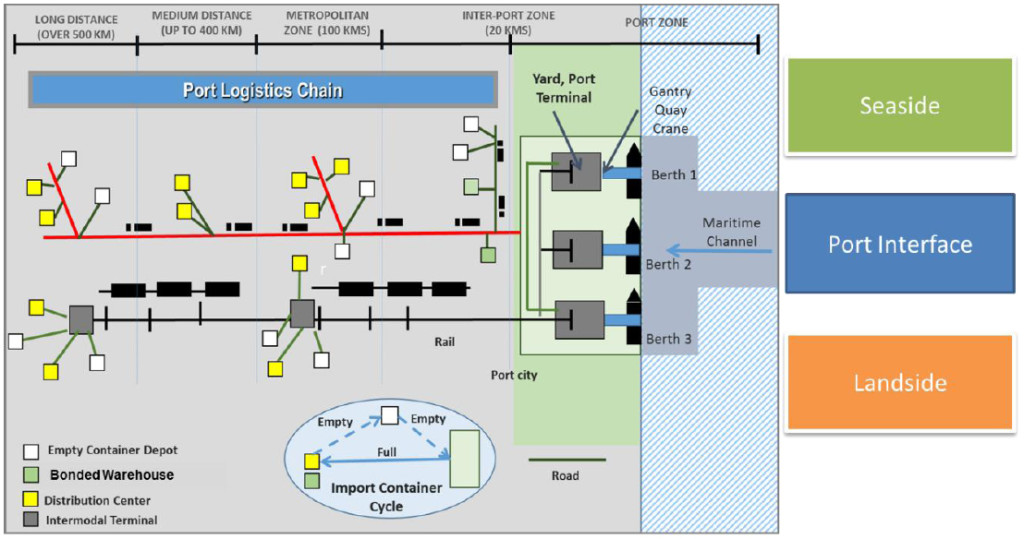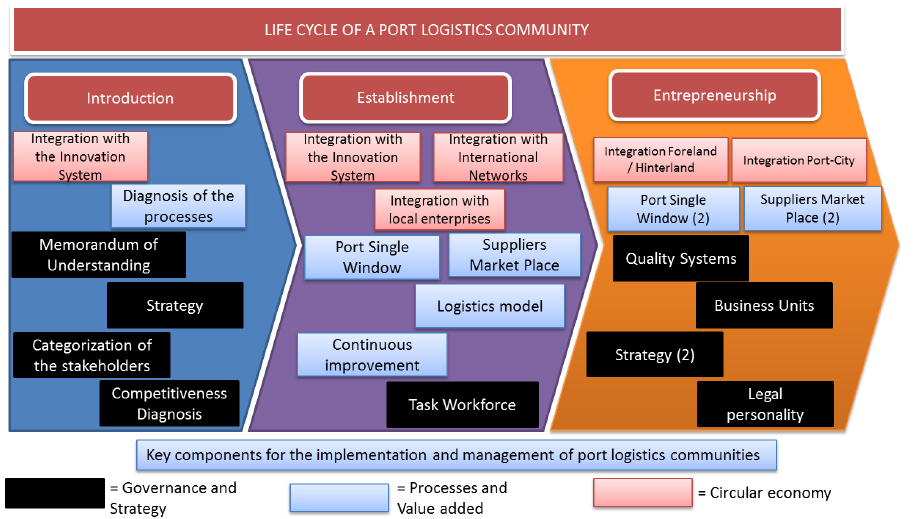Maritime shipping is crucial for international trade and the world economy and given its importance, maritime ports play a key role in the performance of global supply chains. Port infrastructure considers the spatial location and configuration of the different facilities interacting in the port supply chain such as empty container depots (where empty containers are handled, stored and repaired), bonded warehouses that are authorized facilities by Customs where cargo is stored and inspected if required, intermodal terminals for the transfer of cargo with the rail, as well as distribution centers or warehouses of the shippers and consignees of the cargo. The image illustrates the spatial location of the different stakeholders and their facilities that participate in the business processes related to the import and export of cargo.
Spatial location of the different facilities of the port logistics chain.
Global supply chains can obtain greater competitive advantages if efficient ground transport exists between the ports and their hinterland (Lam and Gu, 2013), so that the integration of ports in the supply chain is an element of greater relevance for importers and exporters, which demand more value added services such as traceability of the cargo and agility. Ports as a multi-stakeholder and complex environment require the coordination of the physical and information flows in order to foster efficient port logistics business processes. However, cultural elements and the lack of collaboration among the stakeholders of the port community limit the implementation of technological systems that facilitate the interchange of information and fulfilment of regulatory requirements of foreign trade (Ascencio et al., 2014).
Port logistics communities: new governance for the region
Pinto and Sánchez (2015) have claimed the need of a new governance for the region of Latin America and the Caribbean, what they refer as “governance 2.0”, demanding an analysis of the regional port governance and the need of new conditions to respond effectively to the coming challenges. This includes new institutional models, new legal instruments and a new associative schemes such as the port logistics communities, which is an important element that has been promoted by the D&C Network of ports in the region.
A port logistics community or cluster, is an organizational structure that gathers the different public and private stakeholders involved in the business processes of the port (export and import operations), with the aim to facilitate the dialogue and communication among them, and fosters the analysis and continuous improvement of the international trade procedures. The port logistics community is a public good, but also as a public and private partnership (PPP). This is because some stakeholders and processes are regulated and under different jurisdictions that may be also overlapped. The port logistics community cannot be tendered and is required a governance for the organizational structure and identify a common vision and strategic plan. Based on a life cycle approach, Ascencio (2016) has provided a general framework that is presented in the image.
Life cycle of a port logistics community. (Source: Ascencio, 2016)
The key components for the implementation and management of a port logistics community are the governance and strategy, the business processes and the circular economy. At each stage of the life cycle, we have indicated the basic elements required. For instance, in the introduction stage, a first diagnose of the port logistics community, and characterization of the different stakeholders and their interactions has to be done, in order to define a strategic plan and a general agreement (MOU) among the stakeholders that participate. Another important element is the integration with the innovation system that is compound by universities and consulting companies that provide innovative solutions and develop research.
At the establishment phase, it is necessary to implement continuous improvement strategies to strengthen the logistics model and operations of the port, and design and implement information systems and technology such as the Port Single Window or Port Community System (PCS), market places to facilitate the business, and with respect to the circular economy, it is expected that the port may be able to integrate with international networks and strengthen the integration with the Innovation System of the country. At the entrepreneurship stage it is expected better coordination with the hinterland and foreland and better integration with the port-city. In this regard, more sustainable practices of the port are achieved from the environmental and social perspectives. It is expected that technological projects such as a PCS project may be consolidated in this stage.

